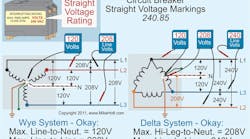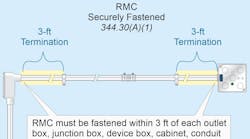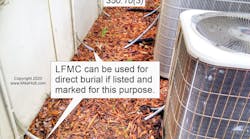All questions and answers are based on the 2011 NEC.
Q. What are the NEC requirements on the termination of the grounding electrode conductor to a grounding electrode?
A. The mechanical elements used to terminate a grounding electrode conductor or bonding jumper to a grounding electrode must be accessible [250.68(A)].
Exception No. 1: The termination isn’t required to be accessible if the termination to the electrode is encased in concrete or buried in the earth.
If the grounding electrode attachment fitting is encased in concrete or buried in the earth, it must be listed for direct soil burial or concrete encasement [250.70].
Exception No. 2: Exothermic or irreversible compression connections, together with the mechanical means used to attach to fireproofed structural metal, aren’t required to be accessible.
A bonding jumper must be installed around insulated joints and equipment likely to be disconnected for repairs or replacement for an underground metal water piping system used as a grounding electrode. The bonding jumper must be of sufficient length to allow the removal of such equipment while retaining the integrity of the grounding path [250.68(B)].
For termination to metal water pipe and structural metal, grounding electrode conductors and grounding electrode bonding jumpers are permitted to terminate to [250.68(C)]:
• Interior metal water piping located not more than 5 ft from the point of entrance to the building/structure [250.68(C)(1)], as shown in the Figure.
Exception: In industrial, institutional, and commercial buildings where conditions of maintenance and supervision ensure only qualified persons service the installation, the entire length of the metal water piping system can be used for grounding purposes, provided the entire length, other than short sections passing through walls, floors, or ceilings, is exposed.
• The metal frame of a building/structure that’s in direct contact with the earth for 10 ft or more [250.52(A)(2)] or connected to one or more of the following [250.68(C)(2)]: a) Concrete-encased electrode [250.52(A)(3)] or ground ring [250.52(A)(4)]; b) Ground rod [250.52(A)(5)];
or c) Other approved earth connection.
Q. What types of conductors are permitted within raceways located in wet locations?
A. Insulated conductors and cables installed in raceways in aboveground wet locations must be listed for use in wet locations according to 310.10(C) [300.9].
Q. What are the requirements for unused openings in enclosures?
A. Unused openings, other than those intended for the operation of equipment or for mounting purposes — or those that are part of the design for listed products — must be closed by fittings that provide protection substantially equivalent to the wall of the equipment [110.12(A)]. Note: Accepted industry practices are described in ANSI/NECA 1, “Standard Practices for Good Workmanship in Electrical Contracting.”
The National Electrical Contractors Association (NECA) created a series of National Electrical Installation Standards (NEIS) that established the industry’s first quality guidelines for electrical installations. These standards define a benchmark or baseline of quality and workmanship for installing electrical products and systems. They explain what installing electrical products and systems in a “neat and workmanlike manner” means. For more information, visit www.neca-neis.org.





